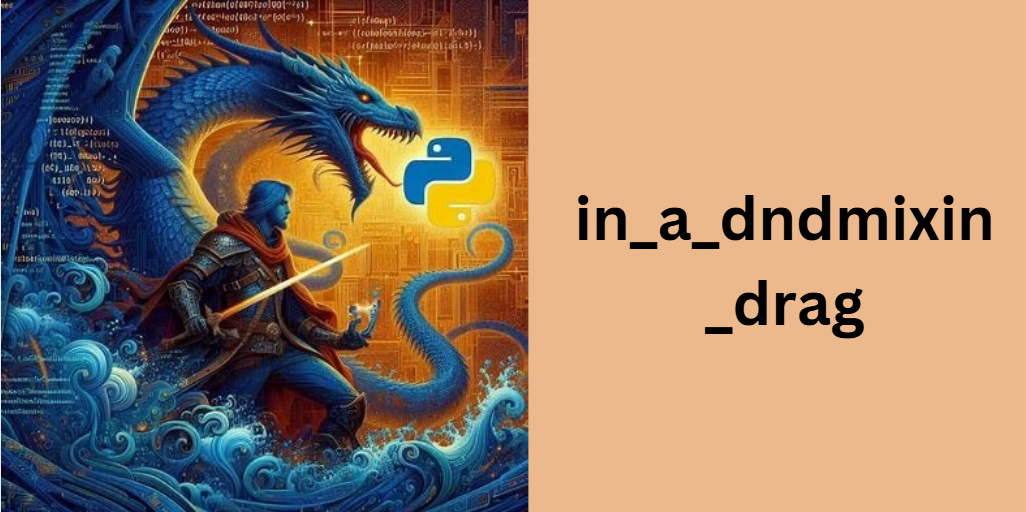Comprehensive Guide: in_a_dndmixin_drag – Uniting Python Mixins with Dungeons & Dragons Mechanics
In today’s innovative development landscape, blending diverse disciplines often leads to groundbreaking ideas. in_a_dndmixin_drag is one such concept that unites Python mixins—a powerful tool for code reusability—with the dynamic drag mechanics found in D&D.
This guide aims to introduce you to the origins of mixins, explain their technical benefits, and illustrate how they can be used to model drag behavior in digital game tools. By understanding this hybrid approach, you will learn how to create more modular, maintainable, and interactive applications.
Background and Context
The term in_a_dndmixin_drag may seem like an abstract combination at first, but it represents a creative convergence of two seemingly disparate fields. On one side, mixins in Python have long been valued for their ability to add functionality to classes without using traditional, rigid inheritance. On the other, Dungeons & Dragons has established a rich set of mechanics, with drag actions playing a crucial role in gameplay—such as moving an unconscious ally or forcing enemy movement during combat.
Historically, object-oriented programming sought to solve code duplication and complexity by encouraging modular design. Mixins emerged as a solution to these challenges, allowing developers to inject reusable methods into multiple classes effortlessly. Simultaneously, D&D’s intricate rules on movement and drag have captivated players with its strategic depth. The synthesis of these two ideas in in_a_dndmixin_drag creates an innovative approach where code techniques mirror game mechanics, opening new avenues for automating and enhancing digital tabletop experiences.
Core Concepts of Python Mixins
Mixins are specialized classes designed to provide additional functionality to other classes. Unlike classical inheritance where a subclass extends a single parent class, mixins allow a class to inherit methods from multiple sources. This approach enhances modularity and promotes code reuse. The benefits are clear: developers can update or extend functionality in one place without modifying a wide range of classes.
For example, consider a mixin that provides a simple drag method. When added to a character class in a game, it equips the character with the ability to perform drag actions seamlessly. The power of mixins lies in their flexibility—they help maintain a clean and manageable codebase while enabling dynamic behaviors.
Dungeons & Dragons Drag Mechanics
In the realm of Dungeons & Dragons, drag mechanics are pivotal for gameplay. Drag actions might involve pulling an unconscious ally out of harm’s way, repositioning an enemy, or even navigating challenging terrain. These actions contribute to the strategic depth of D&D, where every move can be a turning point in an encounter.
In a typical D&D scenario, dragging could involve physical strength checks, environmental hazards, or specific spell effects that force movement. By integrating such mechanics into digital tools using Python mixins, developers can create simulation environments that mimic the rich interactivity of a D&D session. This convergence allows for the automation of complex game logic and provides a foundation for interactive, role-playing experiences in a digital space.
Detailed Explanation of in_a_dndmixin_drag
At its core, in_a_dndmixin_drag encapsulates the application of Python mixins to implement drag functionalities that are inspired by D&D mechanics. Imagine a digital tool where characters can not only move but also interact with their environment using drag actions similar to those seen in tabletop gaming. This approach leverages mixins to keep the code modular and reusable.
An illustrative analogy is to think of a D&D dragon: powerful, versatile, and capable of a variety of actions. Similarly, a mixin can endow a class with multiple abilities without creating complex inheritance trees. The term in_a_dndmixin_drag hence symbolizes the elegant melding of reusable code patterns with dynamic game mechanics.
A simplified flowchart of how mixins integrate into a character class might look like this (described in text):
- A base class, such as a Character, defines fundamental attributes like name and health.
- A DragMixin adds a method to simulate dragging behavior.
- The final class, say Adventurer, inherits from both the base class and the DragMixin, thereby gaining the drag functionality in addition to its core properties.
Coding Examples and Practical Applications
To see in_a_dndmixin_drag in action, consider this basic Python example. Here, a simple mixin adds a drag method to a character:
class DragMixin:
def drag(self, distance):
return f"Dragging object by {distance} meters."
class Character:
def __init__(self, name):
self.name = name
class Adventurer(Character, DragMixin):
def attack(self):
return f"{self.name} launches an attack!"
# Usage
hero = Adventurer("Arin")
print(hero.attack()) # Output: Arin launches an attack!
print(hero.drag(10)) # Output: Dragging object by 10 meters.
In this example, the mixin cleanly adds the drag functionality without complicating the character’s main class structure.
For a more advanced application, consider how mixins can be used to develop a D&D automation tool. Imagine a table summarizing various functionalities:
| Functionality | Mixin Used | Description |
|---|---|---|
| Character Movement | MovementMixin | Handles directional movement and positioning. |
| Drag Operation | DragMixin | Enables characters to perform drag actions during gameplay. |
| Composite Actions | Combined in Class | The character class inherits multiple mixins to support rich, composite behaviors. |
This table illustrates how in_a_dndmixin_drag can serve as a cornerstone in building complex, modular game systems that are both flexible and scalable.
Optimizing and Debugging in_a_dndmixin_drag Implementations
Ensuring smooth performance and ease of maintenance is essential when working with mixin-based designs. When implementing in_a_dndmixin_drag, developers should focus on several optimization strategies. For instance, it is important to minimize unnecessary code execution by reducing redundant method calls and ensuring that mixin methods are lightweight.
Common issues such as method name conflicts or unexpected behaviors in multiple inheritance scenarios require careful planning and debugging. Techniques like unit testing specific mixin functionalities and using Python’s profiling tools can help identify bottlenecks. A checklist for debugging might include:
- Verify that mixin methods do not overlap with those in the base class.
- Ensure that any shared data between mixins and the base class is properly managed.
- Profile performance during drag operations to catch inefficiencies early.
Potential Applications and Future Developments
The applications of in_a_dndmixin_drag extend far beyond simple drag functionality. In game development, this concept can be used to create digital tabletop simulators, automated character movement systems, and AI-driven role-playing game tools. For instance, developers can integrate mixins to manage complex interactions such as status effects, inventory management, or environment-driven challenges.
Additionally, the principles behind in_a_dndmixin_drag have potential in educational tools, where digital role-playing experiences help teach programming concepts through interactive storytelling. The modular nature of mixins ensures that such systems can evolve, allowing future developers to add new features without rewriting large parts of the codebase.
Conclusion
In conclusion, in_a_dndmixin_drag represents a powerful fusion of Python mixins and Dungeons & Dragons drag mechanics. This guide has explored its origins, explained the underlying concepts, provided practical coding examples, and discussed optimization and future applications.
By leveraging mixins to simulate dynamic drag actions, developers can build modular, efficient, and engaging digital tools that echo the rich interactivity of D&D gameplay. This comprehensive resource equips you with the knowledge to implement and innovate using in_a_dndmixin_drag in your projects.
Recommended posts
Resolving svtyper: error: unrecognized arguments: –max_ci_dist 0
1-800-883-4100: The Ultimate Guide to Toll-Free Customer Support
Learning the 9 Most Amazing Things 5-Year-Olds Accomplish 2020 STJCC






